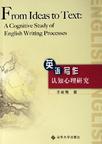英语写作认知心理研究
出版时间:2005-6 出版社:山东大学出版社 作者:王俊菊 页数:347
内容概要
本书从历史与现实的角度分析了前人对英语写作过程的研究,结合认知心理学的最新研究成果,有针对性地研究了中国大学生的英语写作过程,提出了外语写作的思维模式、能力模式、过程模式和教学模式。 本书由三部分组成,共分十四章。除“引言”和“结论与建议”外,第一部分为理论综述部分,分为四章,较为详尽地综述了国内外有关英语写作过程的研究历史和现状,主要包括英语作为母语或第一语言的写作过程研究、英语作为第二语言的写作过程研究、英语作为外语和其他外语的写作过程研究、中国学生的英语写作过程研究。在此基础上分析了前人研究的局限性和研究空白,指出了研究中国学生写作过程的必要性和意义。 本书的第二部分为经验性研究部分,分为六章。首先论证了本研究的设计依据,描述了研究方法的设计、数据的收集和分析;然后叙述了本研究的主要结果和发现,其中包括:三组受试学生的写作过程、写作行为、组内和组间的共同点和不同之处;所使用的写作策略的种类、使用频率、组内和组问的不同和相似之处;学生的英语水平与写作子过程、策略的使用情况、母语的使用情况以及作文文本特点之间的关系。同时发现,学生英语水平的高低能够影响英语写作过程中的写前和写中阶段;学生的英语水平能够影响部分写作策略的使用,存在不同程度的正相关或负相关,在其他一些策略的使用方面,可能存在“门槛”现象;学生的英语水平直接影响到学生思维语言的选择和母语的使用量;学生英语水平的高低明显影响英语作文的文本特点和质量。 本书的第三部分包括三章,主要探讨了外语写作教学的理论框架。首先在前人研究成果的基础上,结合中国的实际情况,分析并讨论了主要研究发现的成因和相关理论依据,提出了有关“语言水平和思想表达”、“二语写作能力”、“中国学生写作过程基本模式”等假设性理论。然后多视角探讨了研究成果对写作教学的启示,强调了过程教学法、写作策略培训、有效使用母语、.蔓为学,而写”和“为写而学”相结合的重要性,并针对中国学生的特点提出宁撼高英语写作教学水平的尝试性建议,构想了“成品一过程一实践”三位一体的写作教学框架。
作者简介
王俊菊,博士,山东大学外国语学院教授,应用英语系主任。1987年获山东大学英语文学学士学位,1993获山东大学双语翻译文学硕士学位,2004年获香港中文大学应用语言学哲学博士学位。1999—2000在英国雷丁大学做访问学者,并访学美国、加拿大,新加坡、韩国等地。长期从事英语教学和应用语言学领域的研究工作。合著有Introduc-tiontoAcademicWriring,主编、参编教材和学习书籍多部,并在AsianJournalofEnglishLaguageTeaching、JournalofAsiarlTEFL等国内外重要学术期刊上发表论文多篇。
书籍目录
Foreword by Guy CookForeword by Yah HuangList of AbbreviationsList of TablesList of FiguresChapter 1 An Overview 1.1 Introduction 1.2 Statement of the Problem 1.3 Purpose and Method of the Study 1.4 Significance of the Study 1.5 Organization of the BookPART I A LITERATURE REVIEW OF PREVEIOUS STUDIES Chapter 2 Studies on ENL Writing Processes 2.1 Introduction 2.2 Studies on the General Writing Process 2.3 Studies on the Sub-processes of Writing 2.4 Cognitive Models of the Writing Process 2.5 Chapter Summary Chapter 3 Studies on ESL Writing Processes 3.1 Introduction 3.2 Studies 0n theGeneral:ProcesS of ESL Writing 3.3 Comparison of L1 and ESL Writing Processes 3.4 Use of the L1 and Translation in ESL Writing Processes 3.5 Chapter Summary Chapter 4 Studies on EFL/FL Writing Processes 4. 1 Introduction 4.2 Comparison of L1 and EFL/FL Writing Processes 4.3 Use of the L1 and Translation in EFL/FLComposing Processes 4.4 Learning Strategy Use and EFL/FL WritingProcesses 4.5 Knowledge Level and EFL/FL Writing Processes 4.6 Chapter Summary Chapter 5 Studies on the Writing Processes of Chinese Learners of English 5.1 Introduction 5.2 Studies on the Writing Processes of Chinese ESL Learners 5.3 Studies on the Writing Processes of Chinese EFL Learners 5.4 Chapter SummaryPART II A QUALITATIVE STUDY ON THE ENGLISH ICVRITING PROCESSES OF CHINESE EFL LEARNERS Chapter 6 Rationale for the Study 6.1 Introduction 6.2 Need for Studies on EFL Writing Processes 6.3 Need for Studies on EFL Writers with Different English Proficiency 6.4 Need for Studies on the Writing Processes of Chinese EFL Learners 6.5 Need for Studies On Norr-English Majors in the Chinese Context 6.6 Methodological Strengths of the Study 6.7 Chapter Summary Chapter 7 Methodology 7.1 Introduction 7.2 Safeguards for the Research Design of the Study 7.3 The Participants 7.4 Sources of Data 7.5 Procedures for Data Collection 7.6 Rationale for the Think-aloud Protocol as the Main Source of Data 7.7 Analysis of the Data 7.8 Chapter Summary Chapter 8 Backgrounds, Perceptio/ts and Attitudes,Writing Processes, and Written Compositions of the Band 4 Group 8.1 Introduction 8.2 Writing Backgrounds of the Band 4 Group 8.3 Perceptions and Attitudes of the Band 4 Group 8.4 Writing Processes of the Band 4 Group 8.5 Features of Written Compositions of the Band 4 Group 8.6 Chapter Summary Chapter 9 Backgrounds, Perceptions and Attitudes,Writing Processes,and Written Compositions of the Band 6 Group 9.1 Introduction 9.2 Writing Backgrounds of the Band 6 Group 9.3 Perceptions and Attitudes of the Band 6 Group 9.4 Writing Processes of the Band 6 Group 9.5 Features of Written Compositions of the Band 6 Group 9.6 Chapter Summary Chapter 10 Backgrounds, Perceptions and Attitudes,Writing Processes, and Written Compositions of the Band 8 Group 10.1 Introduction 10.2 Writing Backgrounds of the Band 8 Group 10.3 Perceptions and Attitudes of the Band 8 Group 10.4 Writing Processes of the Band 8 Group 10.5 Features of Written Compositions of the Band 8 Group 10.6 Chapter Summary Chapter 11 Cross-group Analysis of Subprocesses, Strategies,Written Compositions, and the Role of the Mother Tongue 11.1 Introduction 11.2 Sub-processes 11.3 Adoption of Writing Strategies by Category 11.4 Cross-group Tendencies in Writing Strategy Use 11.5 Role of the Mother Tongue 11.6 Features of Written Compositions 11.7 Chapter SummaryPART III INISIGHTS INTO EFL WRITING AND ITS INSTRUCTIONS IN THE CHINESE CONTEXT Chapter 12 Relating L2 Proficiency to Thought Presentation,L2 Writing Competence, and the EFL Writing Process 12.1 Introduction 12. 2 Audience Awareness, Writing Fluency, Patterns,and Diversities 12. 3 Patterns and Tendencies in Writing Strategy Use 12.4 Mother Tongue, Medium of Thought, and Thought Presentation 12.5 A Model of L2 Writing Competence 12.6 A Model of the Writing Processes of Chinese EFL Learners 12.7 Chapter Summary Chapter 13 Towards.a Model:for EFL Writing Instructions in the Chinese Context 13.1 Introduction 13.2 Pedagogical Implications for EFL Writing Instruction 13.3 Towards a Trinity Model:for EFL Writing Instructions in the Chinese Context 13.4 Chapter Summary Chapter 14 Conclusions and Recommendations 14.1 Summary of the Studio 14.2 Limitations:ofith'e Study 14.3 Suggestioris fortFurther Research 14.4 Concluding RemarksReferencesAppendix Ⅰ QuestionnaireAppendix Ⅱ The Writing PromptAppendix Ⅲ Questions Guiding Semi—structured Interviews
章节摘录
Generally speaking, research into ENL composing processesmoves along at least two complementary and sometimes overlappinglines (Bridwell, 1980). The first consists of those studies that focuson observations of writers at work to investigate the general writingprocesses or the general pattern of different subprocesses The second includes those that examine certain specific as-pects of composing processes to suggest evidence for a cognitive/de-velopment theory of writing In the follow-ing, the Studies on ENL writing processes are described in three sub-sections hy focusing respectively on studies on the general writingprocess, the subprocesses of writing, and some cognitive models ofthe writing process. Studies on ENL writing processes started with those that reas-sessed the nature of writing. Emig (1971) did one of the earliestlandmark studies that "responded to the shift in composition orienta-tion from product to process". In her TheComposing Processes of Twetfth Graders, Emig pioneered a labora-tory case study approach by adopting the methods of verbal protocol,observation, and post-event interviewing techniques. Emig met fourtimes with her subjects, eight high school seniors who were selectedby their teachers a.s good writers. She observed the students duringtheir oral writing, took notes, and recorded the composing-aloudprocesses. She also interviewed the subjects and collect;ed studentspreliminary notes. ……
编辑推荐
本书从历史与现实的角度分析了前人对英语写作过程的研究,结合认知心理学的最新研究成果,有针对性地研究了中国大学生的英语写作过程,提出了外语写作的思维模式、能力模式、过程模式和教学模式。本书供从事英语工作的人员或相关研究人员阅读参考。
图书封面
评论、评分、阅读与下载
用户评论 (总计2条)
- 印刷纸张质量好像不太好,不过最关键的是内容!
- 很好 很及时
推荐图书
- 食品质量检验
- 食品质量检验
- 计算机应用基础
- 计算机应用基础实验指导
- 中国衡器实用技术手册
- 定量包装商品净含量保证指南
- 食品微生物学检验
- 常用量具手册
- 石油计量
- 《卓越绩效评价准则》问答与实例
- 管理的系统方法
- 安全工程实验与鉴别技术
- 中国十环标志与质量 环境和职业健康安全三大管理体系一体化认证实施指南
- 质量管理
- 一体化管理体系审核
- 材料成分检验
- 制造业质量信息管理
- 建筑行业ISO14001
- 现代轧制参数检测技术
- 饮料质量检验
- SN/T 1443-2004《食品安全管理体系》系列标准理解要点
- 计量认证和审查认可工作文件汇编
- 流变与地球动力学
- 西南地区强地震短期前兆特征和预测方法研究
- 吐鲁番盆地新生代环境演变
